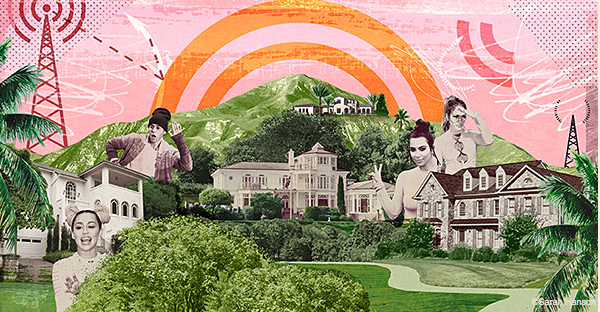How the super-rich are making their homes ‘invisible’
There is nothing remarkable about 23726 Long Valley Road — except that it does not appear to exist.
Estate agents’ advertisements show that the high-end Californian home — six bedrooms, pizza oven, pool — is situated in a gated community on the edge of Los Angeles. Yet prospective buyers searching online to check out the neighbourhood are wasting their time — none of the area’s 648 homes appear on Google Street View.
All that online maps show of the area are street routes and names — what could perhaps be an outline plan for a future housing development. But anyone looking for a kerbside view of the property will find no evidence of it.
The community’s name gives a clue why: it is called Hidden Hills. What the area’s occupants — who reportedly include Kim Kardashian, Miley Cyrus, Justin Bieber and Jennifer Lopez — value above all is privacy. That includes banning Google’s photography vehicles from entering (and declining to talk to the FT; a spokeswoman for the area’s management company said it had a policy of not giving interviews to the press).
Academics have long used the names “hidden communities” or “invisible communities” to denote areas with high concentrations of deprivation and social marginalisation. Yet some of the world’s most privileged people are choosing to hide from the public eye to protect their homes from burglars and other forms of unwelcome attention.
In an evermore connected world, privacy is perhaps the greatest luxury anyone can buy.
This demand for under-the-radar living has fuelled the spread of places like Hidden Hills. California has several other neighbourhoods that guard their privacy by refusing to appear on Street View, including Bradbury and Bell Canyon. All are among the most affluent neighbourhoods in the US.
Author and futurist Geoff Manaugh, whose book A Burglar’s Guide To The City documents these attempts to take entire communities out of the public gaze, calls it an “urban-scale non-disclosure agreement”.
The occupants of such areas “do not want to be discussed” and operate on the basis that “out of sight [means] out of mind — and out of the reach of burglars,” he writes.
Privacy is perhaps the greatest luxury anyone can buy, hence the trend for properties hidden from prying eyes and online searches
Sarah Hanson's illustration of celebrities with 'invisible' homes©Sarah Hanson
There is nothing remarkable about 23726 Long Valley Road — except that it does not appear to exist.
Estate agents’ advertisements show that the high-end Californian home — six bedrooms, pizza oven, pool — is situated in a gated community on the edge of Los Angeles. Yet prospective buyers searching online to check out the neighbourhood are wasting their time — none of the area’s 648 homes appear on Google Street View.
There are people who still want curb appeal but many others don’t want anyone to know where they live
Tweet this quote
All that online maps show of the area are street routes and names — what could perhaps be an outline plan for a future housing development. But anyone looking for a kerbside view of the property will find no evidence of it.
The community’s name gives a clue why: it is called Hidden Hills. What the area’s occupants — who reportedly include Kim Kardashian, Miley Cyrus, Justin Bieber and Jennifer Lopez — value above all is privacy. That includes banning Google’s photography vehicles from entering (and declining to talk to the FT; a spokeswoman for the area’s management company said it had a policy of not giving interviews to the press).
Academics have long used the names “hidden communities” or “invisible communities” to denote areas with high concentrations of deprivation and social marginalisation. Yet some of the world’s most privileged people are choosing to hide from the public eye to protect their homes from burglars and other forms of unwelcome attention.
In an evermore connected world, privacy is perhaps the greatest luxury anyone can buy.
This demand for under-the-radar living has fuelled the spread of places like Hidden Hills. California has several other neighbourhoods that guard their privacy by refusing to appear on Street View, including Bradbury and Bell Canyon. All are among the most affluent neighbourhoods in the US.
Author and futurist Geoff Manaugh, whose book A Burglar’s Guide To The City documents these attempts to take entire communities out of the public gaze, calls it an “urban-scale non-disclosure agreement”.
The occupants of such areas “do not want to be discussed” and operate on the basis that “out of sight [means] out of mind — and out of the reach of burglars,” he writes.
To be clear: these options are not a true stealth strategy, hiding you from the tax authorities or security services. But they are a way of avoiding more casual unwanted attention, from nosy neighbours to the paparazzi.
“There was a time when people really flaunted their wealth; now they don’t,” says David Forbes, head of private office at estate agent Savills who advises wealthy buyers. “People’s priorities over the years have shifted. Now right at the top of the list it’s security.”
read rest of the article here http://www.ft.com/cms/s/2/7a707048-648d-11e6-8310-ecf0bddad227.html#axzz4IMCfrMHL

Haven't read just yet but will after I write. All I know is that I will be there one day so, curious to see what they do :)
I can't wait to get my spot in the Hills! I seen some nice hidden spots myself up in L.A.(valley) as I got a chance to live with wealthy distant relatives back when I was 16. I was fortunate to witness a lot out there :) But yes, privacy is an issue and a luxury to have. Nice article!